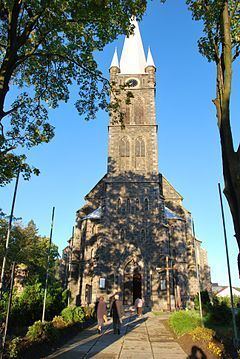Area 7.73 km² Local time Sunday 9:03 PM | Postal code 57-250 Population 2,930 (2006) | |
 | ||
Weather 14°C, Wind NW at 6 km/h, 65% Humidity Points of interest Muzeum Górnictwa i Hutnictwa, Leśny Park Przygody Skalisko, Średniowieczny Park Techniki | ||
Złoty Stok [ˈzwɔtɨ ˈstɔk] (German: Reichenstein, Czech: Rychleby) is a town in Ząbkowice Śląskie County, Lower Silesian Voivodeship, in south-western Poland. It is situated on the border with the Czech Republic, adjoining the Czech village Bílá Voda.
Map of Z%C5%82oty Stok, Poland
The name Złoty Stok means "golden slope" in Polish and is a reference to the fact that a gold deposit was mined here in the Middle Ages.
The town is the seat of the administrative district (gmina) called Gmina Złoty Stok, and lies approximately 16 kilometres (10 mi) south of Ząbkowice Śląskie and 77 kilometres (48 mi) south of the regional capital Wrocław. Prior to 1945 it was in Germany. (For more information about the history of the region, see Silesia.)
Złoty Stok/Riechenstein was, for many prisoners of war, a stopping place on 'The Long March' during the final months of the Second World War in Europe. About 30,000 Allied PoWs were force-marched westward across Poland, Czechoslovakia and Germany in appalling winter conditions, lasting about four months from January to April 1945.
As at 2006, the town has a population of 2,930.
Its Czech name is applied to the neighbouring mountain range, the Rychleby Mountains (Czech: Rychlebské hory). The corresponding Polish name is Góry Złote (Golden Mountains). This range is part of the eastern Sudetes.
There is a number of historical monuments in the town, including the Museum of Gold Mining and Metallurgy (Muzeum Górnictwa i Hutnictwa Złota w Złotym Stoku). The first evidence of mining in Zloty Stok dates from the first millennium AD. At the beginning of the 16th century the town, called Reichenstein (Richstone) by the Germans, began to flower thanks to the mining and working of gold. The search for this precious ore continued until the closing of the mine in the late 1960s, this, even though it had not fully rendered all its wealth.
